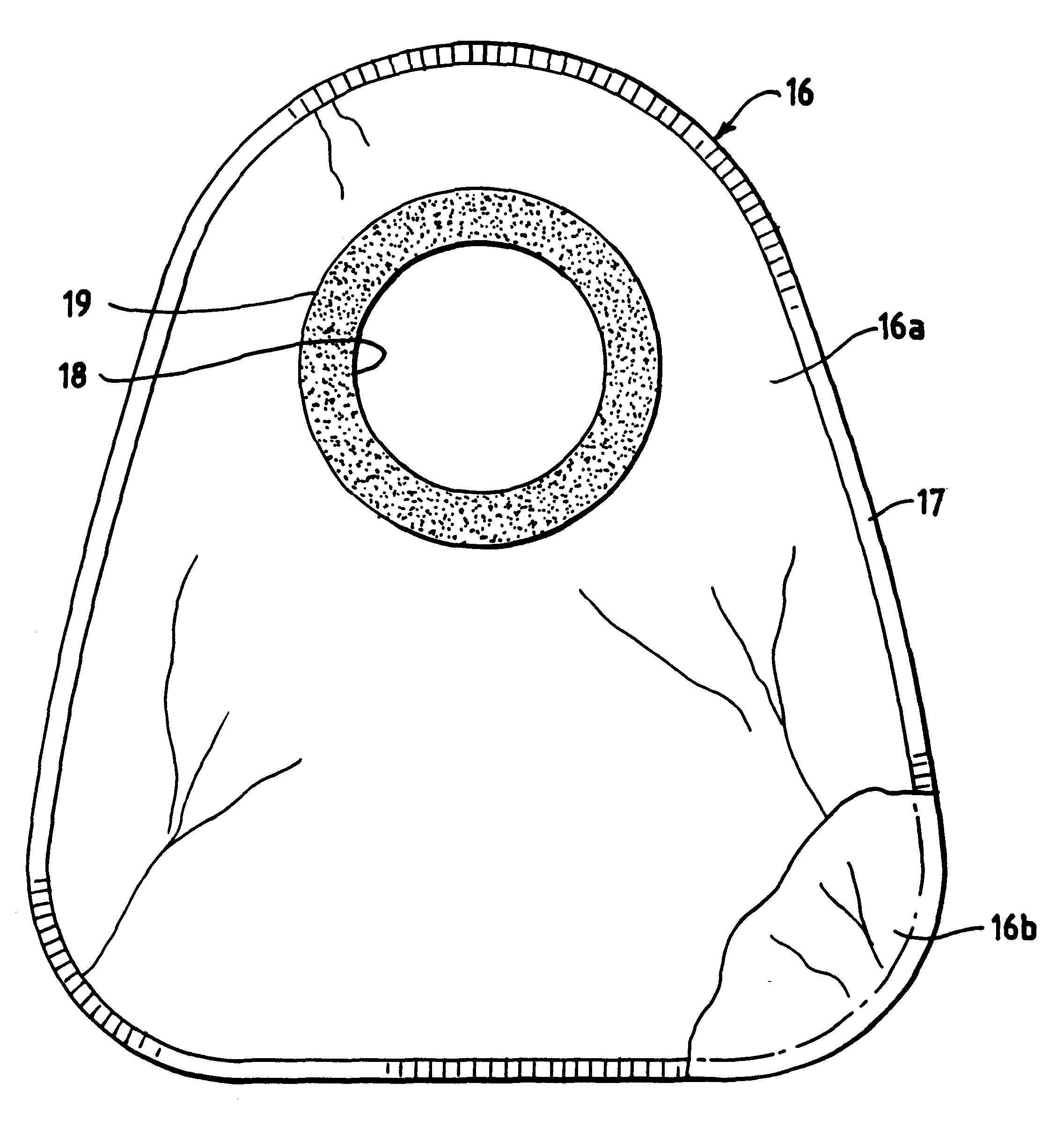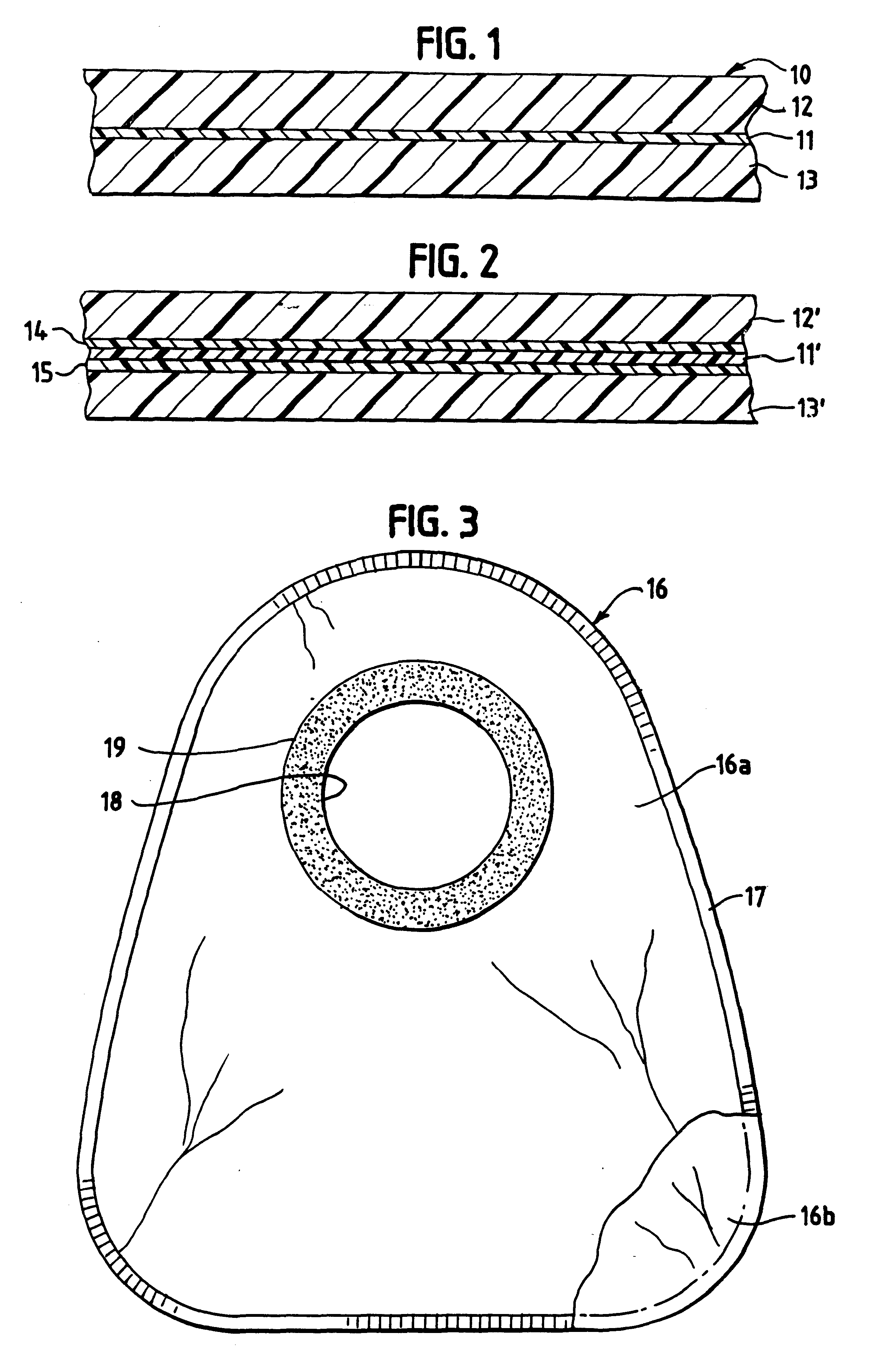Multilayer chlorine-free film with polyester barrier layer and ostomy pouches formed therefrom
a chlorine-free film and polyester barrier technology, applied in the direction of synthetic resin layered products, transportation and packaging, other domestic articles, etc., can solve the problems of solid waste disposal problems, odor barrier properties, and stiffness of chlorine-free barrier resin films, so as to avoid embarrassment for users, reduce noise, and good odor barrier properties
- Summary
- Abstract
- Description
- Claims
- Application Information
AI Technical Summary
Benefits of technology
Problems solved by technology
Method used
Image
Examples
example 2
A three-layer barrier film in accordance with this invention was produced by coextrusion using conventional coextrusion casting techniques at 535.degree. F., resulting in a multilayer film having a total thickness of 3 mil and a core barrier layer thickness of 0.2 mil. The composition of the barrier layer was toughened polyethylene terephthalate (Selar PTX184, duPont Co.) and skin layers of ethylene methyl acrylate copolymer with 20% methyl acrylate (EMAC SP1257, Chevron Chemical Co.).
Using the same procedure described in Example 1, the tensile moduli (psi) of the films were measured with the secant modulus at 2% elongation being determined in both machine direction and transverse direction. Noise emissions produced by the films were analyzed with a sound level meter in the same manner as described in Example 1. The comparative data appears in Table 2 below:
Tensile modulus and noise data reveal that a film embodying the invention having an EMA skin layer with a 20% methylacrylate co...
example 3
A five-layer barrier film was produced in accordance with this invention by coextrusion casting, resulting in a film with a total thickness of 3.5 mil and a barrier layer thickness of 0.3 mil. Unlike the films of the previous examples which utilize EMA resin as the skin layer, in this example the skin layer is based on polyethylene. Specifically, the film structure is A / B / C / B / A, wherein A is a polyethylene-based resin (2M042), Exxon Chemical Co.) modified by the addition of 5% of a slip / antiblock concentrate (EXT4226TSE, A. Schulman Co.) and 3% of a low density polyethylene (LD200.48, Exxon Chemical Co.); B is a tie layer consisting of anhydride-modified EMA (Bynel 21E533); and C is toughened polyethylene terephthalate (Selar PTX174, duPont Co.). The Bynel tie layer is particularly advantageous in this film structure to maximize adhesion to the polyethylene skin. Again, the tensile modulus at 2% elongation and the film noise were measured as described in the previous examples. The d...
example 4
The barrier properties of the film of Example 3 were tested using three model compounds for fecal odor: dimethyldisulfide, indole and skatole. For comparison, the same test was conducted on a commercial ostomy film with chlorinated barrier. Analysis of effluent gases was conducted by gas chromatography using a flame ionization detector. The table below shows breakthrough times and concentration of each component in the effluent stream after 60 hrs.
Better barrier properties are expected for films that show longer breakthrough times and lower effluent concentration. The film of Example 3 is superior to the chlorinated control in both respects, indicating superior performance as a barrier to fecal odorants.
PUM
| Property | Measurement | Unit |
|---|---|---|
| thickness | aaaaa | aaaaa |
| thickness | aaaaa | aaaaa |
| thickness | aaaaa | aaaaa |
Abstract
Description
Claims
Application Information
 Login to View More
Login to View More - R&D
- Intellectual Property
- Life Sciences
- Materials
- Tech Scout
- Unparalleled Data Quality
- Higher Quality Content
- 60% Fewer Hallucinations
Browse by: Latest US Patents, China's latest patents, Technical Efficacy Thesaurus, Application Domain, Technology Topic, Popular Technical Reports.
© 2025 PatSnap. All rights reserved.Legal|Privacy policy|Modern Slavery Act Transparency Statement|Sitemap|About US| Contact US: help@patsnap.com


